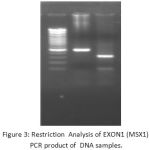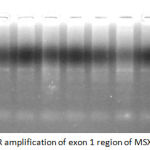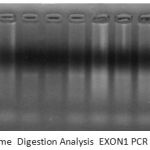C. Deepak1 and Arvind Ramanathan2
1Department of Orthodontics, Bharath University Chennai, India
2Sree Balaji Dental College and Hospital Bharath University Chennai, India.
Corresponding Author E-mail: drcdeepak1307@gmail.com
DOI : https://dx.doi.org/10.13005/bpj/1207
Abstract
To understand the role of a homeobox gene (MSX1) in South Indian non-Syndromic cleft palate patients. A cross sectional study was made of non-Syndromic cleft lip and palate patients. The study was conducted at an Orthodontic Department of a Post graduate teaching hospital. Twenty five patients (South Indian ) were included in the study,the inclusion criteria consisted of ,non-syndromic oral clefting, cl/p,and absence of a tooth or teeth ( partial tooth agenesis). Clinical examination Case Summary, and radiographic evidence of missing teeth were taken .Blood samples were taken after a written consent, and were collected in 1.5 ml polypropylene microfuge tubes , transferred to the genetic laboratory in a box of dry ice. Genomic DNA was isolated for all patients and controls and exon 1 site (MSX1) was sent for polymerase chain reaction amplification. The PCR (polymerase chain reaction) product was further sent for restriction enzyme analysis with 0.5 units of MboII. A Mutations search done in the exon 1 region of the MSX1 gene was reported in a study done by Vandenboogard et al.15, a dutch family showing non –syndromic oral facial cleft lip and palate , this research study was done to find if any mutation of a homeobox gene (MSX1 exon 1 region) could have been involved in the Indian non-syndromic oral clefting. There was a perfect digestion of the enzyme, thus confirming that there was a absence of mutation in all the patient samples. Conclusion: The finding of absence of mutation in all the selected patient samples correlated with those reported for a predominately Caucasian population (Lidral et al.,1998),but they not correrate with those reported from a study of a Dutch Family(vanden Boogerd et al., 2000).The findings from this study are very significant as they establish that a mutation of MSX1 gene could have a diverse genetic involvement .As this study was done in the coding region of the selected gene it can be further expanded to include all the non-coding regions.
Keywords
Homeobox gene;MSX1 exon 1 Gene; Poly merase chain reaction; Mutations South Indian Non-Syndromic clefting;
Download this article as:| Copy the following to cite this article: Deepak C, Ramanathan A. MSX1 Gene Mutations in South Indian Population - A Genetic Research. Biomed Pharmacol J 2017;10(3). |
| Copy the following to cite this URL: Deepak C, Ramanathan A. MSX1 Gene Mutations in South Indian Population - A Genetic Research. Biomed Pharmacol J 2017;10(3). Available from: http://biomedpharmajournal.org/?p=16280 |
Introduction
Cleft Lip and palate is considered as , among the most common birth defects to affect mankind. The Children affected with this, are handicapped, for breast feeding, defective speech altered swallowing patterns, frequent naso-bronchial infection, growth and development of maxillary arch defects and overall individual facial development, affecting the personality of the affected person.1,2
Non-Syndromic Cleft Lip and Palate
The most commonly proposed genetic model of a non-syndromic Cleft lip and Palate is that of multifactorial threshold inheritance by (Carter.C.O 1969).4 According to their model the occurrence of the disorder depended upon the cumulative effects of several of minor abnormal genes (polygenes) and also environmental factors. The accumulation of these minor and environmental factors is tolerated by the developing fetus only to a particular threshold point and beyond that there was a risk for malformation, the proposed (MF/T) model.
Homeo Box Genes
Recent research in the field of genetics has proved that there are an existence of a very large pool of genes, some of which seem to be highly conserved, and possibly responsible for coding of transcription factors and are involved directly in the regulation of down stream genes, known as homeobox genes.3
The word homeobox was originally found in the homeotic genes of the fruitfly` Drosophila Melanogaster’, they are mainly responsible for specific segment identity in the developing fruit fly. Homeotic genes as they are known, usually exhibit a specific feature called co-linearity,and their spatial arrangement which is along the chromosome, seems to be in the same order as their patterns of expressions. Several mutations in these homeotic genes have lead to bizarre transformations where one segment of the fruit fly has been transformed into another segment.
MSX Genes (Muscle Segment Homeobox)
The MSX Genes found in vertebrates, comprise of a small family of genes related to the drosophila fruit fly gene, muscle segment homeobox (MSH). The MSX genes are found in some vertebrate specific tissues including the neural crest, bone and teeth and cranial sensory placodes. There are two classes of MSX genes (muscle segment homeobox), the MSX1 and the MSX2 gene. A third class of MSX gene the (MSX3) has been identified in the mouse.3
Direct evidence involving the function of MSX genes (muscle segment homeobox) at the tissue level, relates to mutations. Experiments with MSX1 deleted mice failed to form some teeth and have shown several craniofacial abnormalities, which included the absence of the alveolar bones of both the jaws and several abnormalities in parietal,nasal membrane bones, frontal, malleus of the ear and cleft lip and palate.3
Contemporary research in cleft palate genetics is centered around western countries, the design and study the probable genetic etiology of Indian non-syndromic cleft lip & palate patients, was needed for an indepth understanding of non syndromic genetics of clefting will help the clinicians to understand the development of cleft lip and palate, and also develop the field of prenatal genetic counseling.
Aims and Objectives of the Study Were
The aim of study was to understand the role of Homeobox genes in the etiology of South Indian Dravidian non-syndromic CLP (cleft lip and palate)patients.
Objectives of the Study Included
Amplify the chosen region of a Homeobox gene ( MSX1 exon 1) from a South Indian cleft lip and palate patient sample.
Perform a detailed mutation search.
Discuss results and clinical significance of this study.
Materials and Methodology
Case Sample Size
Twenty non syndromic cleft lip and palate patients were randomly selected for this study, the patient consent was obtained prior to the study , appropriate institutional review board approval was also obtained. The study conformed to all the protocols as specified in the Helsinki declaration for studies on humans.
The Patients were selected on the following criteria ;
South Indian Non-Syndromic cleft lip and palate patients .
A Clinical evidence showing some tooth agenesis.
Bilateral and unilateral cleft lip / palate patients were studied .
Clinical history was taken ,case history and the diagnosis was recorded on specific patient records . A written consent for the study was taken from the patients.
Chemicals Used in the Study
Sodium Dode cyl Sulphate (SDS), Trizma base, Ethylene Diacetyl Tetra Acetate (EDTA), Glyceral, Formamide, Boric Acid and Dimethyl Suloxide (DMSO) were purchased from Sigma Chemical Co, USA.The dideoxy-nucleotide triphosphates were purchased from Pharmacia Biotech .Agarose procured from FML bio – products, the USA. Molecular weight (Gene Ruler, 100bp) purchased from Genei Pvt Ltd, India.
TAQ – Polymerase
TAQ – Polymerase was procured from Perkin Elmer , and Pharmacia Biotec.
Primers
Primers for MSX1 gene Exon 1 FOR -5’CGG ACA TGA CTT C -3’,MSX1 REV 5’- GCC TGG GTT CTG ACT AC -3‘
Restriction Enzyme used
Mbo II
Sourced from an E Coli Strain that carries cloned Mbo II gene of the Moraxella bovis.
Reaction Buffer
10 nM MGCL2, 50 mM ,Dithiothreitol (ph 8.0 at 24°C) and incubated at 37°C.
Storage Conditions
10 nM TrisHcl (ph 7.8 ), EDTA, 2 nM Dithio Thresitol, 0.2 mM, 50% Glycerol ,Stored at -20°C.
5’….GAAGA7∆…..3’
3’….CTTCT8∆……….5’
Methodology
The venous blood samples were taken from south Indian non –syndromic cleft lip and palate patients and were collected using sterile 2 (ml)disposable syringes.
1.5 ml of venous blood taken from each patient, was collected transferred to 2 ml polypropylene micro fuge tubes .
The blood samples were stored in -20°c freezer until the DNA isolation procedure.
Extraction of Genomic DNA of the Patients
Genomic DNA can be taken by different methods. It is usually a simple procedure but great caution should be taken to a make sure no contamination of DNA occurs from any other sources like contaminated glass wares, plastic tubes and specific buffers used for the DNA extraction. Polymerase Chain Reaction (PCR) is a very effective and sensitive method for DNA amplification, small amounts could cause contamination of the DNA and would be amplified ,and potentially alter the results.
Results of the Study
The genetic eitiology of non-syndromic cleft lip& palate has shown the role of a major homeo box gene namely the MSX1 in the development of Non –Syndromic cleft lip and palate.7,8 The linkage of genetic diseases is usually attributed to defective gene (s),the presence of a specific mutation in a homeobox gene ( MSX1 gene)7 would prove its role in South Indian non-syndromic cleft lip and palate patients.
 |
Figure 1: The Genomic DNA isolates from blood samples. |
Genomic DNA were taken from the Peripheral lymphocytes ,of 25 patient blood samples.
The Genomic DNA was isolated by Proteinase K and SDS digestion, followed by Phenol/Isoamy alcohol extraction and .2M/95% Ethanol precipitate.
Further the precipitated genomic DNA as suspended in MQ and was electrophoresed in a 0.8 agarose gel.
 |
Figure 2: The PCR amplification of exon 1 region (MSX1) of the placental DNA samples. |
The Placental DNA was used as control and was amplified with specific primers pairs .
Lane 1: Molecular Weight marker (100 bp ruler )
Lane 2: 482 bp product of exon1 of MSX1 amplified from DNA.
 |
Figure 3: Restriction Analysis of EXON1 (MSX1) PCR product of DNA samples. |
15 µl of PCR product of EXON1 (MSX1) of DNA was digested using 2 units of Mbo11 in a 50 µl at 37 °c . The next day ,DNA from the reaction was precipitated. by addition of 2.5 volumes of 0.1M Sodium Acetate. The DNA was suspended in 10µl Mq and left in 2% agarose gel. The restriction digestion resulted in two products of sizes 322 bpand 160 bp respectively.
The band corresponding to the region between 300 bp and 400 bp marker and the band corresponding to the region between 200 bp and 100 bp marker confirms a perfect digestion, and the confirms result.
 |
Figure 4: The PCR amplification of exon 1 region of MSX1 of the patients. |
The DNA were amplified using specific primer pairs , and an aliquot of 10µl was electrophoresed in 2% agarose gel .
Lane 1: MW (Molecular Weight marker 100 bp ruler )
Lane 2-16 : 482 bp product of Exon1 was amplified from the peripheral DNA.
 |
Figure 5: Restriction enzyme Digestion Analysis EXON1 PCR product of DNA sample.
|
A 10 µl aliquot of PCR product of EXON1 MSX1 from the DNA isolated from CL/P patients was reacted with 2 units of MboII, in a 20 µl reaction, at 37 °c overnight.
A band corresponding to the regions between 300 bp and 400 bp markers confirmed the perfect digestion ,and hence the product. However since the band corresponding to the regions between 200 bp and 100 bp markers is not clearly visible in this picture, because of a higher DNA concentration.
Lane 1: Molecular Weight Marker (100 bp ruler )
Lane 2: Undigested ( Control) placental DNA
Lane 3-17: The digested patient CL/P samples.
Discussion
Non-Syndromic cleft lip and palate is considered a common congenital anomaly with medical, social , phycological and economic ramifications.7
Non-syndromic cleft lip and palate has always been thought to have a multifactorial etiology . It has been reported in literature that with a significant increase in both Dental and Dermatoglyphic asymmetries within individuals with cleft lip/palate.
Recent studies have given a direct evidence to the role of the MSX1 gene (earlier known as the Hox1), in the normal development and formation of craniofacial structures including the tooth formation.3
The Homeobox genes are considered as the master genes , controlling ,induction , patterning, and programmed cell death during the development of the craniofacial complex.3
In a systematic review done by M. Phan et al, where the authors thoroughly investigated the contemporary literature in an attempt to identify the genomic loci and genes which contributed to syndromic or non syndromic clefting and tooth agenesis . A total of 26 candidate genes were found of which MSX1 was one candidate gene.10
Those of special interest on development of craniofacial region include the MSX1,MSX2,OTX,GSC,and Shh.5,6,7,12
Genetic Mutation in MSX1 gene for South Indian population was reported by VekannaS Prasad and Venkatesh Shivani.16 The authors reported a mutation (414 to T).
Our study of EXON 1 region of MSX1 gene did not reveal any mutation of the clp samples.
This establishes the genetic diversity of MSX1 mutation.
Furthermore studies may be designed to search for mutations in the non coding regions of MSX1 gene.
The exogenous application of TGFB3 as part of anti-Scarring therapy following surgical correction of the cleft , may be beneficial to those individuals.11 ,13,14 The study done on a Dutch family,reported by (VandenBoogard,et al,2000)15 with mutation in 12 affected members in a family, prompted an interest to conduct a similar study in the context of South Indian Non-Syndromic patients, aimed to understand the genetic abnormality in such cases.
A positive finding in the form of a mutation would help to understand a genetic abnormality in the Indian CLP patients. Such a finding is very important to understand the development of clefting, and for therapeutic possibilities in these unfortunate patients.
Conflict of Interest
There is no conflict of interest.
Funding Source
The Authors would like to thank Bharath University for the Funding of the study.
References
- Niswander J. D. A. Development `noise’ and congenital malformation. Genetics Research. 196;10:313.
- Niswander J. D. A. Oral clefts in the American Indian. Public Health Rep. 1967;82:807.
CrossRef - Lidral A. C and Reising B. C. The Role of MSX1 in Human tooth agenesis. J Dent Res. 2002;81(4):274-27.
CrossRef - Carter C. O. Genetics of Common Disorders. Br.Med. Bul. 1969;25:52.
CrossRef - Hu D.,Helms A. J. The role of Sonic hedgehog in normal and abnormal craniofacial morphogenesis. Development. 1999;126:4873-4884.
- Evans R. M. The steroid and thyroid hormone receptor super family. Sceince. 1988;240;887-885.
CrossRef - Furgeson M. N. J. A hole in the head. Nature genetics. 2000;24:330-331.
CrossRef - Lakshmi N. J. R.Genetic,cytogenetic and teratologic studies of cleft lip and cleft palate;Phd Thesis,University of Madras. 1988.
- Lidral A. C.,Romitti P. A.,Basart A. M. Association of MSX1 and TGFB3 with non –syndromic clefting in humans. Am J Hum .Genet. 1998;63:557-568.
CrossRef - Phan M.,Conte F., Khandelwal K. D., Ockeloen C. W.,Bartzela T., Kleefstra T.,Van Bokhoven H. Rubini M., Zhou H and Carels C. E. L. Tooth agenesis and orofacial clefting genetic brothers in arms ? Human Genet. 2016;135(12):1299-1327.
CrossRef - Proetzel G.,Mackenzie R. The role of TGFB3 in the Development of craniofacial region. Nature Genetics. 1996;11:409-414.
CrossRef - Satokata I.,MAAS R. Msx1 deficient mice exihibit cleft palate and abnormalities of abnormalities of craniofacial development. Nature genetics. 1994;6:348-355.
CrossRef - Shah M.,Recombinant T. g FB3-A therapeutic possibility. J.Cell.Science. 1995;108:985-1002.
- Taya Y. Exogenous TGFB3 in palatal fusion defects. Development. 1999;126;3869-3879.
- Boogard V.,Dorland M. J. H.,Beemer F. A. M. MSX1 mutation is associated with orofacial clefting and tooth agenesis in Humans(letter). Nature Genet. 2000;24:342-343.
CrossRef - Prasad S. V., Shivani V. Genetic significance of muscle segment homeo box1 gene in South Indian population for cleft lip and palate. Indian Journal of Human genetics. 2012;18(3):332-339.
CrossRef








